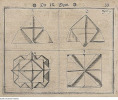ITEM 1. NAPKIN FOLDING: ITEM 2. THE BEAUTY OF THE FOLD.
ITEM 1. Series of Fully Illustrated Original Designs. Printed by Newton and Eskell. 1891. Full-page diagrams throughout with facing letterpress description with forty-nine designs including: The True-Lovers' Knot; The Cockle-Shell; The Lady Betty Balfour; The Turkey-Cock Tail; The Spill-Box; The Four-Pointed Fan; The Duplex Vase; and The Opera Glasses. ITEM 2. THE BEAUTY OF THE FOLD. A Conversation with Joan Sallas. Edited by Charlotte Birnhaum. Sternberg Press. ON THE TABLE SERIES.
ITEM 1. SOLE EDITION. 4to. Inside cover advertisements for Newton & Eskell publications. (1)List of designs. Verso Advert for Alfred Suzanne's Egg Cookery. No title page (not-proven, if one is called for). (1)Napkin Folding. 6-103. Each verso with explanation of Napkin shapes. Opposite page with each Napkin diagram. Last 3 pages + inside cover: Advertisements for Newton & Eskell publications. Covers are very lightly dusted. A very small damp stain to the top of the covers. Very light staining to the last two pages. Back cover advert for 'The Caterer and Hotel-keeper.' Publisher's cloth-backed printed boards. Spine re-backed with dark green cloth spine. Overall a very nice item. ITEM 2. FIRST EDITION. 2012. 183 x 113mm. 2feps (one with publisher's details. Title page. 1p Contents. [1] 7-9 Forward. On the verso; 2 b/w photographs of a huge feature from a 1677 folding manual. 11-27. [1] 2nd Title page. 30-86. The b/w photographs of folding techniques. [1] Verso with Advertisements. 1fep. Hard cardboard cream covers with decoration and text in maroon. Condition as new.
- ITEM 1. Napkin folding is most commonly encountered (but less often nowadays) as an elaborate table decoration in fancy restaurants. Although the modern trend is for clean, unstarched, simply folded white cloths, that have had the minimum of handling, giving a sense of good conscious health and safety awareness. It is now becoming quite rare to see the elaborate folded fantasies of the past. Typically, and for best results, a clean, pressed, well-starched square cloth (linen or cotton) napkin was used. There were many variations in napkin folding in which a rectangular napkin, or a napkin ring, a glass, or even multiple napkins may have been used. The earliest instruction manual for the artistic folding of napkins was published in 1639 by Matthia Gieger, a German meat carver working in Padua. It was part of a series of treatises on the culinary arts titled 'Le Tre Trattati'. Napkin folding has a centuries-old history and dates back to the times of Louis XIV of France (1638 – 1715), also known as Louis the Great (Louis le Grand) or the Sun King (le Roi-Soleil). He was the monarch of the House of Bourbon who ruled as King of France from 1643 until his death. The shift of the napkin from simply a folded cloth to a folded creative object occurred in 16th century Florence, Italy around the same time as voluminous clothing, such as ballooned sleeves, had become fashionable among the wealthy. Rather than simply laying a tablecloth flat on a table, starched linens were folded into large centre-pieces, called "triumphs," that could depict a variety of real and mythical animals, natural elements and architectural forms. (See item 1098 on this book-site, titled, 'Roger, Earl of Castlemaine's Embassy' by Michael Wright to get a sense of the amazing "triumphs" made from sculpted sugar pastilliage). A popular gift wedding guests received during this time was a personally folded napkin that distinguished whether they were related to the bride or groom. In the mid-18th century, table setting practices were so specific that in Germany there were particular traditions on how to fold napkins, display figures at the table and arrange plate. During this golden age of napkin folding, there was a school in Nuremberg devoted entirely to this art and butlers had shelves of instructional books to keep up with the changes in the field. Napkin folding in the form of table sculptures began being replaced by porcelain decorations during the 18th century. When I was in the Catering school in the early 1960's we students used to enjoy learning new shapes of folded napkin fantasies. Another age another time. ITEM 2. Features German master Joan Sallas, whose folded napkins graced the Metropolitan Museum's exhibit of 1780 Viennese royal table silver. (Watch him fold a ''water lily'' napkin on YouTube.) A virtuoso of the fold, has meticulously researched and mastered the history and techniques of the art of the fold. With the banquet table as a setting, his expertise and philosophy pour forth in the form of splendid, folded linen. In this precious book, Sallas shares his folding wisdom, which editor Charlotte Birnbaum contextualizes in two essays on the history of napkin folding. The texts are accompanied by an illustrated catalogue of folding techniques. A fascinating little book and a good accompaniment






click on image to enlarge

Antiquarian category
ref number:
11293